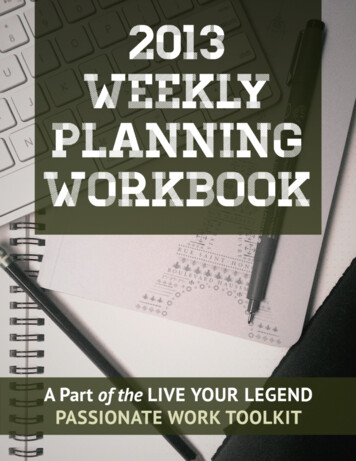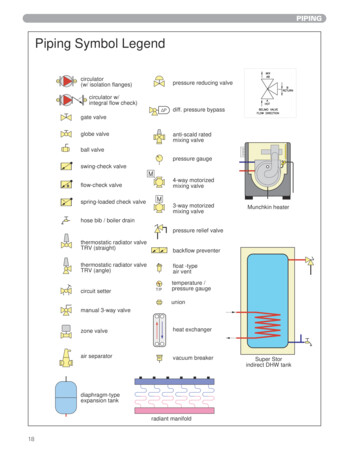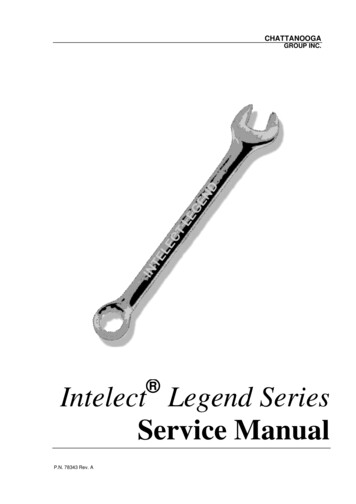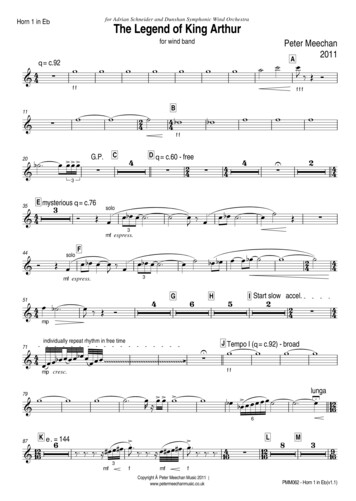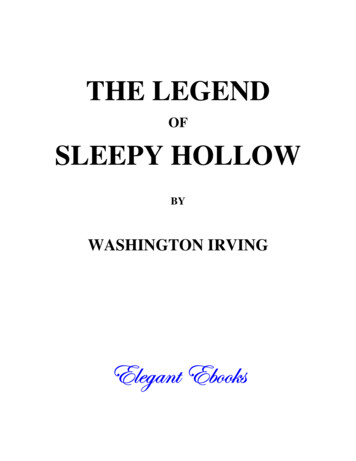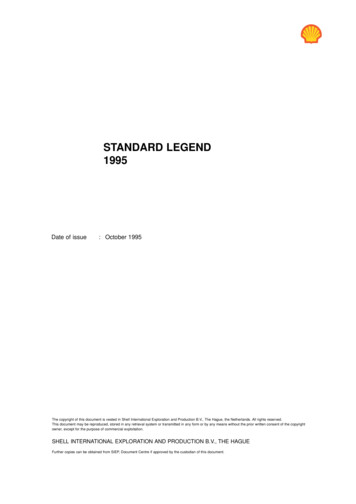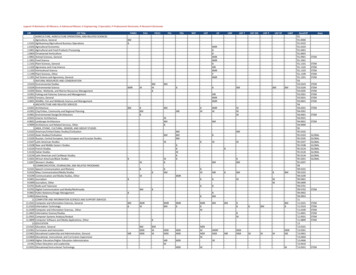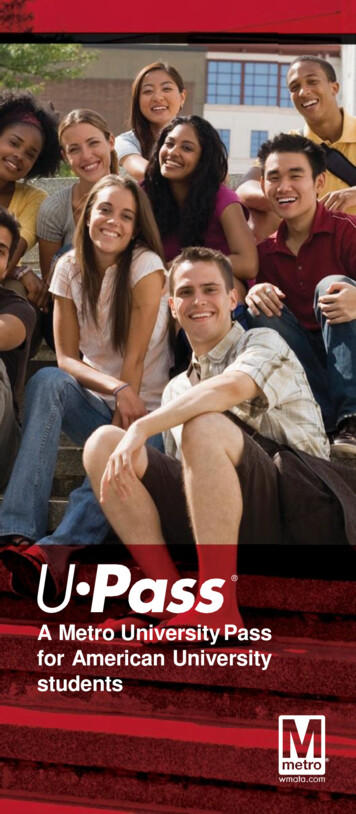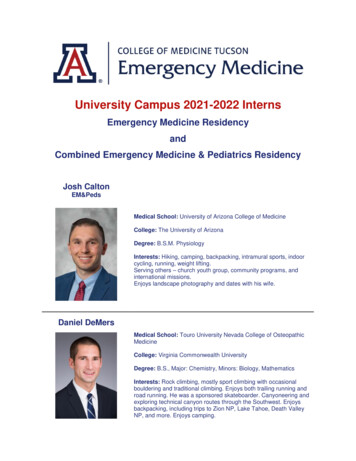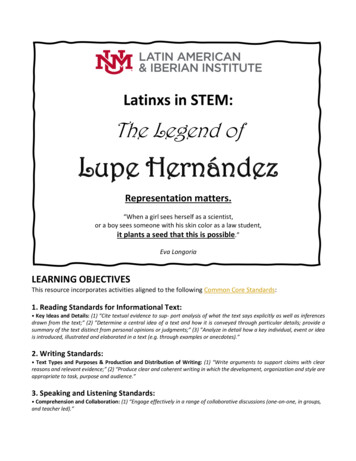
Transcription
Latinxs in STEM:The Legend ofLupe HernándezRepresentation matters.“When a girl sees herself as a scientist,or a boy sees someone with his skin color as a law student,it plants a seed that this is possible.”Eva LongoriaLEARNING OBJECTIVESThis resource incorporates activities aligned to the following Common Core Standards:1. Reading Standards for Informational Text: Key Ideas and Details: (1) “Cite textual evidence to sup- port analysis of what the text says explicitly as well as inferencesdrawn from the text;” (2) ”Determine a central idea of a text and how it is conveyed through particular details; provide asummary of the text distinct from personal opinions or judgments;” (3) ”Analyze in detail how a key individual, event or ideais introduced, illustrated and elaborated in a text (e.g. through examples or anecdotes).”2. Writing Standards: Text Types and Purposes & Production and Distribution of Writing: (1) “Write arguments to support claims with clearreasons and relevant evidence;” (2) “Produce clear and coherent writing in which the development, organization and style areappropriate to task, purpose and audience.”3. Speaking and Listening Standards: Comprehension and Collaboration: (1) “Engage effectively in a range of collaborative discussions (one-on-one, in groups,and teacher led).”
Name:Date:ACTIVITY 1Due to the COVID-19 Global Pandemic,hand sanitizer has become a hot commodity, but what do we really know who inventedit and why they invented it?Before starting the following activities, answer the questions below using your previous knowledgeor take a best guess. These three questions will be answered in the following activities.1. When was hand sanitizer invented? You can guess a decade or era if you don’t know the exact year.2. Who created hand sanitizer? What type of job or industry do you think the inventor worked in?3. Why was hand sanitizer invented? Who was it made for?During the following activities, answer the questions below using information provided in the video.https://www.youtube.com/watch?v dvwwKvbPQU41. According to this video, who created handsanitizer?2. What was the creator’s job title?3. What was the issue that the creator ofhand sanitizer wanted to address?Write 1 question you have about the creator of hand sanitizer:4. What were the benefits of hand sanitizer?1
Name:Date:ACTIVITY 2Guiding questions for Alejandra Reyes-Velarde’s “Did a Bakersfield Nursing StudentInvent Hand Sanitizer? Coronavirus Reignites the Lupe Hernandez Debate”1. Reyes-Velarde refers to Lupe Hernandez as a debate or legend. What does shemean by this?2. Map out the two sides of the Lupe Hernandez debate that Reyes-Velardeoutlines throughout the article:--------3. Based on the arguments for either side presented in the article, which side doyou believe is credible? Explain why using information in the text and your ownopinion.2
Name:ACTIVITY 3Date:What makes a source credible?Thanks to the internet, there are numerous claims and stories shared via multiple outlets. How can wemake sure the news and stories that we come across are true? Check out this guide from the Universityof Maryland Global Campus’s Library for some tips to help you determine if a source is dibility.cfmUsing the link above,refer to the last section on “Truth in the News.” Take notes andsummarize their suggestions for each of the following strategies they provide below.- Check the facts:-Evaluate sources:-Beware of:-Burst your filter bubble:Application activity: Using the suggestions above, are the video and news article that youwatched and read credible? Explain why or why not.3
5/coronavirus-hand-sanitizer-urban-legendDid a Bakersfield Nursing Student Invent Hand Sanitizer?Coronavirus Reignites the Lupe Hernandez DebateBy: Alejandra Reyes-VelardeApril 25, 2020Over the last decade, the legend of Lupe Hernandez from Bakersfield has bounced around the medicalworld.Haven’t you heard? She’s the student nurse who invented hand sanitizer.Or so the story went.Most accounts give a specific date for her breakthrough: 1966. Some say Hernandez did it at BakersfieldCollege, prompted by a lack of soap and hot water.Others claim that this novice Florence Nightingale registered a patent for her concoction, but biggercompanies such as Gojo Industries, the makers of Purell, appropriated it. (Gojo denies it.) Nearly alltellings identify Hernandez as a woman, but a few insist that Lupe — short for “Guadalupe” — was aman.Nursing textbooks, college professors and presenters at medical conferences repeated the tale, but thestory didn’t circulate far beyond their circles.Then the coronavirus outbreak hit.Media outlets worldwide started to report on Hernandez’s “discovery.” They began to call Bakersfieldhistorians and librarians — and Lupe Hernandezes (public records show at least 30 people with thatname live in the city).“If a hand sanitizer company wants to pay me 50,000, I’ll tell them whatever they want. But that’s notmy mother,” said Eric Gaona, 53, the son of one Lupe Hernandez from Bakersfield.Even a Russian journalist reached out to inquire about his mother, Gaona said. Far from being a nurse,she was a former singer in a 1960s girl group called the Rev-Lons.There are no U.S. patents for hand sanitizer under that name. None of the articles that recount her storycite any primary sources. In Bakersfield, a town that proudly promotes its celebrities — BuckOwens, Merle Haggard, Dolores Huerta — few had even heard the story of “Lupe” — until recently.Cal State Bakersfield archivist Chris Livingston has searched newspaper archives and databases andfound nada. Bethany Rice, curator of collections at the Kern County Museum, did the same with thesame result.4
“At this time, I’m treating the story as a great example of why to check sources when reading somethingonline and how to verify facts in an article,” she said, even recording a video to emphasize this point. “Iwould love for the story to be true and it would be an incredible boon to the community if it were, butat this point there is nothing supporting that.”Oliver Rosales, a history professor at Bakersfield College, said Kern County medical histories are oftenadministrative and “whitewashed.” “It’s a fantastical story because of how important hand sanitizer isnow,” he said. “As a historian, I’m skeptical, but I’m curious. If it is true, why hasn’t somebody writtenabout her?”They have. But at this point, the truth — Lupe Hernandez from Bakersfield is almost certainly a modernday urban legend — is not so important to those who continue to spread the story. Lupe is now a folkhero in the most literal sense, glorified because of what her “story” and its creation mean to them.In the wake of a run on hand sanitizer that has cleared out store shelves nationwide, some Latinos bragon social media about how one of their own invented it. Digital posters with a photo purported to beof Hernandez flourished throughout March in honor of Women’s History Month.When Cindy Collier, director of Bakersfield College’s Health and Wellness Center, recently heard the tale,it didn’t surprise her that a nurse might think of an idea such as hand sanitizer. She sees how a fullyplausible saga about a nurse’s MacGyver moment decades ago could have been twisted and passeddown over the years.“Nurses in general, because of desperation when we don’t have what we think we need, we tend to bevery ingenious,” Collier said. “Every one of us will have a story where we created something to make ourlife easier or our patients safer, and we never did anything about it.”If a Latina nurse did invent hand sanitizer, Collier said, that “would really be a neat thing to be able tosay as a nurse, especially with what’s going on right now in the world.”The earliest mainstream publication to peg a Lupe Hernandez from Bakersfield as the inventor of handsanitizer is probably the Guardian, which referred to the “student nurse” in a 2012 articleIn an email, reporter Laura Barton says her notebooks from the time are in a storage facility she currentlycan’t get to, but that her “suspicion [is] my source may have been American. I just can’t remember whoor what or where it came from.”There is nothing that indicates “Lupe” was known anywhere before this. Not in Bakersfield lore, not inthe annals of nursing, not even among Latinos, where tall tales about the purported connection ofHispanics to glory — did you hear the one about how Walt Disney was a Spanish orphan? — abound.Whatever the case, Barton’s article percolated through the American nursing world.Angela Barron McBride, former dean of the Indiana University School of Nursing, included Hernandez ina 2019 update of her textbook for nurses. In an email, McBride said she “wanted to give concrete5
examples of nurse inventors and was pleased to come across a Latina student nurse’s name. I don’t knowanything more about what happened to her.”Rachel Walker, a professor at University of Massachusetts Amherst College of Nursing, has namedropped Hernandez in speeches as someone she tries to emulate.“But when I went back to try to substantiate the story,” she said, “I, too, ran into challenges.”Maribel Alvarez, a professor of folklore at the University of Arizona, isn’t surprised that evenprofessionals would repeat a historical anecdote with an unclear provenance.“This story is indexing something in the culture,” she said. “People want to believe it because it explainssomething in their world.”That’s why, Alvarez explains, “Lupe Hernandez from Bakersfield” has now taken on a second life amongLatinos.“Crises are the Petri dish of folklore,” she said. “Rumors and legends act like viruses. They flare up in hotspots, and then they disperse.”The story of “Lupe” is spreading as Latinos disproportionately suffer from the pandemic — as victims ofcoronavirus, as workers in jobs deemed “essential” with little protection, and also from its economicimpact.In such times, affected communities look for a hero — and so people comfort themselves with “Lupe,”Alvarez said.“The legend always works in a reversal mode. El que está arriba está abajo; el de abajo sube [The mightyfall; the meek rise]. In this case, Lupe has a possession that others need. What does that tell you? It talksabout all the things we don’t value that mexicanos bring.”But Alvarez also stresses that most folklore has “bits and pieces of a truth. Each one of those pieces —the nurse, the Bakersfield, the name — probably together add to a bigger picture of what the real storyis.”For now, Lupe Hernandezes and their families across the country continue to deal with strangerswondering if they’re that Lupe.In Colorado, Leshi Hernandez, the daughter of the woman whose photo has circulated online as the Lupebehind the sanitizer, has dug through her late mother’s belongings to try to verify any connection. Thechances are slim: Leshi’s mother spent her life in Wyoming and Colorado as a homemaker andhousekeeper. In 1966, she would have only been 13.“We’re kind of just stunned because my mom’s picture came up,” Leshi Hernandez said. “How did sheend up linked to all this and where did they get that picture?”6
On an online obituary page for a Lupe G. Hernandez, who passed away in 2007, someone left a commentlast year that reads: "[Thank] you for hand sanitizer. It helps a lot of people be germ free!”Meanwhile, Bakersfield’s Lupe Hernandezes and their relatives are taking their brush with celebrity instride.Lupe Hernandez Turner, a 62-year-old nurse from Bakersfield, said she’s gotten a handful of calls fromreporters over the last few weeks who have asked if she invented hand sanitizer.Even one of her friends sent her a message.“They said, ‘Hey, is this you?’” Hernandez Turner said. “I was like, ‘Uh, nope, first I’ve heard of it.’”Though she is a nurse, Hernandez Turner would have been only 8 in 1966. She became a nurse in 1979and used her married name Lupe Turner by then.“Hey, who knows?” she joked. “I could have been a child prodigy!”Times staff writer Scott Wilson contributed to this report.7
Whatever the case, Barton’s article percolated through the American nursing world. Angela Barron McBride, former dean of the Indiana University School of Nursing, included Hernandez in a 2019 update of her textbook for nurse
